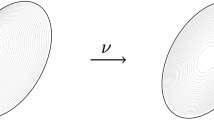Abstract
One of the methods of reducing the frictional resistance of bodies moving in water is the discharge of a water-soluble polymer admixture into the turbulent boundary layer on the surface of the body. For dilute polymer solutions having constant concentration, existing semiempirical methods of calculation which use information on the effect of long molecules on the rearrangement of the flow in the boundary layer enable one to calculate the resistance of smooth and rough tubes [1] with sufficient accuracy and to analyze effects of the redistribution of local tangential stresses on the surface of plane plates [2]. Methods of calculating the drag of plates that have been developed up to the present time are also suitable for predicting the reduction of turbulent friction of elongated bodies by polymer admixtures. It is of interest to generalize these methods to the case of variable concentration. Below we consider the problem of calculating the turbulent boundary layer on a plane plate when a polymer solution is injected near its leading edge. For its solution we use the simplifying assumption that it is possible to replace the actual distribution of the concentration of polymer admixtures along a normal to the surface of the plate with an effective uniform distribution. This assumption enables us to estimate the discharge rate of the polymer that is required to obtain a given reduction in the frictional resistance.
Similar content being viewed by others
Literature cited
N. G. Vasetskaya and V. A. Ioselevich, “Construction of a semiempirical theory of the turbulence of dilute solutions of polymers,” Izv. Akad. Nauk SSSR, Mekhan. Zhidkost. i Gaza, No. 2 (1970).
N. G. Vasetskaya and V. A. Ioselevich, “Polymer admixtures in the boundary layer of a plane plate,” Tr. In-ta mekhan. MGU, No. 30 (1973).
M. Poreh and J. E. Cermak, “Study of diffusion from a line source in a turbulent boundary layer,” Internat. J. Heat and Mass Transfer,7, No. 10, 1083–1095 (1964).
A. G. Fabula and T. J. Burns, “Dilution in a turbulent boundary layer with polymeric friction reductions,” TP 171, Naval Undersea Research and Development Center, Pasadena, Cal. (1970).
M. J. Rudd, “Velocity measurements made with a laser dopplermeter on the turbulent pipe flow of dilute polymer solution,” J. Fluid Mech.,51, No. 4 (1972).
I. O. Khintse, Turbulence. Its Mechanism and Theory [in Russian], Fizmatgiz, Moscow (1963).
Yu. F. Ivanyuta and L. A. Chekalova, “Experimental investigation of turbulent flow of dilute solutions of polymers in tubes of various diameters,” Inzh.-Fiz. Zh.,21, No. 1 (1971).
I. K. Nikitin, N. G. Poznyaya, and A. V. Dzevaltovskii, “Velocity profile and frictional drag in the turbulent flow adjacent to a wall of dilute polymer solutions,” Gidromekhanika, Resp. mezhv. sb. No. 19 (1971).
H. Schlichting and K. Schlichting, Bounday Layer Theory, McGraw-Hill (1968).
Author information
Authors and Affiliations
Additional information
Translated from Izvestiya Akademii Nauk SSSR, Mekahnika Zhidkosti i Gaza, No. 1, pp. 63–68, January–February, 1974.
The authors thank L. I. Sedov and S. S. Grigoryan for useful discussions of the results.
Rights and permissions
About this article
Cite this article
Ioselevich, V.A., Pilipenko, V.N. Drag of a plane plate in a stream of a polymer solution having variable concentration. Fluid Dyn 9, 47–51 (1974). https://doi.org/10.1007/BF01016308
Received:
Issue Date:
DOI: https://doi.org/10.1007/BF01016308




